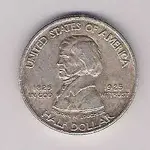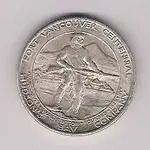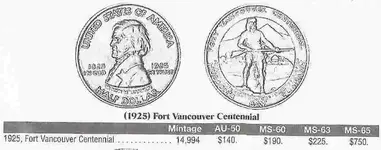I did a little google search and found out some interesting history of my half.
The coins were sold for $1 each during August and September of 1925, with the majority selling during the weeklong Centennial celebration that began on August 17. Though 50,028 coins were minted, sales were disappointing, and 35,034 pieces were returned to the Mint to be melted, leaving a net mintage of 14,994, including the 28 coins remaining with the Assay Commission. One matte proof was reported by Walter Breen, and two other such pieces are rumored to exist.
The nature of the design openly exposes the high points of Vancouver halves, and this, coupled with the lack of any special packaging or handling, destined much of the issue to suffer from friction and abrasions. In addition, well-struck coins showing the details of the trapper’s hand, face and right thigh and chest are scarce. Wear first appears on McLoughlin’s bust, especially on the cheekbone and hair above the ear and on the knee on the reverse. Although Vancouver halves are not difficult to locate in grades through MS-64, MS-65 or better specimens are quite elusive. Unfortunately, counterfeits of this issue are known: they exhibit many depressions that at first seem to be bag marks, along with tooling marks on the reverse below letters CEN in CENTENNIAL.
An interesting tale involving Vancouver halves was recently revealed. In August of 1926, Governor Charles Sale of the Hudson’s Bay Company purchased 1,000 examples of the Fort Vancouver half dollar. These coins were moved to the Provincial Archives Building in Winnipeg, Manitoba, Canada in 1974. In the summer of 1982, a caretaker stole them and spent 400 pieces at face value. Needing money for a new car, he took the remaining 568 pieces to a bank in Winnipeg where they were exchanged by a teller for $284 in Canadian funds. The savvy teller then received permission from her supervisor to buy them from the bank at face value. After they were counted out in a coin-counting machine, they were sold to a Canadian dealer for $37,500.
The dealer sold 522 pieces to clients in the United States and Canada and retained 46 pieces for himself. He had checked with both the FBI and the Royal Canadian Mounted Police who then weren’t yet aware of the theft. Although he had received clearance from the authorities, the dealer was eventually sued by the Crown. In the end, he prevailed and retained ownership of the 46 remaining pieces. No attempt was ever made to recover the other specimens.
I wonder if this coin was one of the stolen coins?
I will try and take a digital pic of this (the scan I took looks a lot pixelated) in the next day or so and post it on this thread.



 but can't complain
but can't complain 




 but can't complain
but can't complain 








